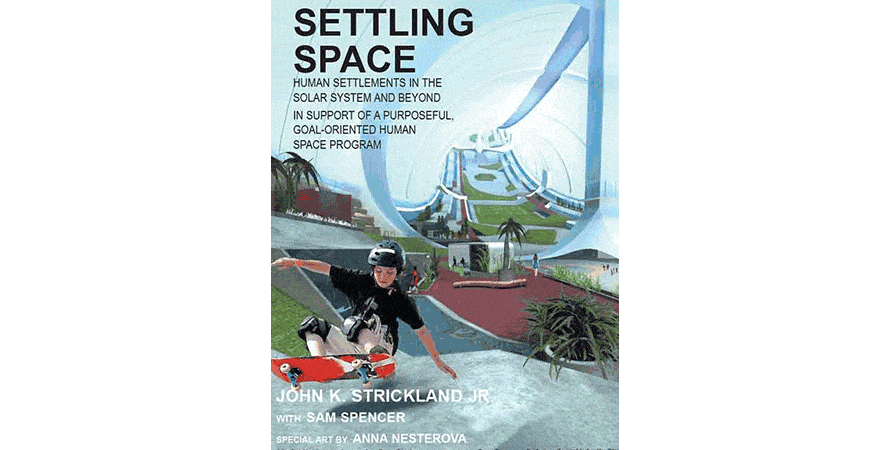Category: Nonfiction
Reviewed by: Casey Suire
From Ad Astra Fall 2021
Title: Settling Space
Author: John K. Strickland Jr.
NSS Amazon link for this book
Format: Paperback
Pages: 398
Publisher: Apogee Books
Date: January 2021
Retail price: $45
ISBN: 978-1989044162
As I read Settling Space, one thought kept going through my mind: Strickland has thought of everything! No matter how ambitious the goal or destination, he explains, in very great detail, how it is possible. By the end of the book, Strickland is describing human travel to the stars. Ad Astra!
Settling Space, the sequel to Developing Space, begins with Mars. Readers will learn how and why humanity should journey to the Red Planet. The book, which does an excellent job of keeping up with current space developments, details SpaceX’s ongoing plans to reach Mars with the Starship rocket. Other mission architectures, such as Strickland’s Access to Mars concept and Buzz Aldrin’s Mars cyclers, are examined. Once on Mars, astronauts will need to perform important tasks like growing food and producing power for the growing settlement. Later on, a chapter on terraforming debates the best way to make Mars more Earth-like. Options like nuclear weapons and asteroid impacts are viewed unfavorably. One alternate method involves mining nitrogen on Pluto and transporting it to Mars.
Terraforming Mars isn’t the only long-term vision for human space settlement. Free-floating space colonies are also given a lot of attention. This is interesting considering the current rivalry between SpaceX and Blue Origin. While SpaceX wants to transform Mars from a dead planet into a habitable one, Blue Origin wants to build free-floating space colonies using space-based resources. You won’t find this disagreement in Settling Space. Both ideas are covered in a positive way.
Considering all the information inside both Developing Space and Settling Space, it is no surprise that the books took several years to write. John Strickland, the primary author of the series, didn’t do it all alone. In Settling Space, co-author Sam Spencer contributed to both the Mars settlement chapter and another chapter on how asteroids are both a threat and a resource. The asteroid chapter has plenty of interesting and eye-popping details. For example, NEO (near-Earth object) and main-belt asteroids have a combined mass of 2,800 quintillion metric tons. That is enough resources to support an estimated 48 quadrillion people for 10,000 years! What international space law, such as the Outer Space Treaty and the SPACE Act of 2015, has to say about asteroid mining is briefly mentioned.
Anna Nesterova’s art takes on an even greater meaning in Settling Space than in Developing Space. She does a great job depicting such concepts as future Martian settlements and the nitrogen mining operation on Pluto. Quite possibly her finest work is illustrating the construction of a Stanford Torus. Until such a structure is actually built, Nesterova’s work is one of the best ways to visualize what building a free-floating space colony will be like. Of all the wonderful images in the book, the Stanford Torus art stands out above the rest.
As with any challenging endeavor, the idea of space settlement and terraforming has its detractors. Criticism falls into various categories: political, philosophical, technical, and scientific. It even comes from Hollywood, as there are films that incorrectly portray the human expansion in space. Strickland handles the naysayers very well by pointing out the flaws in their logic.
One such example is a 2018 scientific paper pointing out that Mars can’t be terraformed with current technology due to an insufficient amount of carbon dioxide. As a result, several news articles quickly claimed that terraforming Mars was totally impossible. Strickland does agree that there isn’t enough carbon dioxide to raise the atmospheric pressure of Mars. However, he notes that having a mostly carbon dioxide atmosphere is not desirable in the first place. Strickland’s answer to the paper’s findings is his idea to import nitrogen to Mars. He also outlines other processes that will help terraform Mars.
In the book’s introduction, it is noted that “the future in space has not looked so bright since the years just before Apollo 11.” After a half-century of stagnation, this does appear to be the case. Between the reusable rocket revolution and a growing list of private space companies, space is exciting again. It is time to settle space.
© 2022 Casey Suire
Please use the NSS Amazon Link for all your book and other purchases. It helps NSS and does not cost you a cent! Bookmark this link for ALL your Amazon shopping!



















